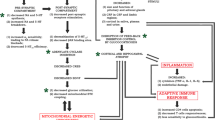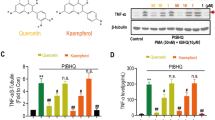Abstract
An increasing body of evidence indicates that glial activation and neuroinflammation play an important role in the pathogenesis of psychiatric and neurodegenerative diseases. Activated glial cells secrete various cytokines that influence neurotransmission, hypothalamus–pituitary–adrenal axis activity, neuronal plasticity and neurogenesis. It has been suggested that alterations in cytokine networks are involved in the mechanism of action of antidepressant drugs. Until now, only a few studies demonstrated that some tricyclic antidepressants and selective serotonin reuptake inhibitors reduced production of pro-inflammatory cytokines in brain glia cells. We have investigated for the first time whether the antidepressant, moclobemide (a reversible selective inhibitor of monoamine oxidase-A) has an influence on pro-inflammatory cytokines [interleukin (IL)-1β and tumor necrosis factor (TNF)-α] and anti-inflammatory cytokine (IL-10) in primary rat mixed glial cell cultures stimulated by lipopolysaccharide (LPS). Our results showed that moclobemide used in a wide range of concentrations diminished LPS-stimulated IL-1β and TNF-α mRNAs expression in cellular extracts and remarkably reduced the levels of both pro-inflammatory cytokines in culture medium. In opposite to this, the drug had no influence on IL-10 mRNA and slightly reduced IL-10 concentration. Moreover, moclobemide decreased LPS-stimulated translocation of NFκB p65 subunit into cellular nuclei. These results suggest that moclobemide exerts anti-inflammatory effect in the central nervous system because it affects the balance between pro- and anti-inflammatory cytokines (IL-1β, TNF-α/IL-10) in primary mixed glial cell cultures.






Similar content being viewed by others

References
Allain H, Lieury A, Brunet-Bourgin F, Mirabaud C, Trebon P, Le Coz F, Gandon JM (1992) Antidepressants and cognition: comparative effects of moclobemide, viloxazine and maprotiline. Psychopharmacology 106:56–61
Boland A, Gérardy J, Mossay D, Delapierre D, Seutin V (2002) Pirlindole and dehydropirlindole protect rat cultured neuronal cells against oxidative stress-induced cell death through a mechanism unrelated to MAO-A inhibition. Br J Pharmacol 135:730
Bonnet U, Leniger T, Wiemann M (2000) Moclobemide reduces intracellular pH and neuronal activity of CA3 neurones in guinea-pig hippocampal slices-implication for its neuroprotective properties. Neuropharmocology 23:2067–2074
Bradford MM (1976) A rapid and sensitive method for quantitation of microgram quantities of protein utilizing the principle of protein-dye binding. Anal Biochem 72:248–254
Chiou SH, Ku HH, Tsai TH, Lin HL, Chen LH, Chien CS, Ho LL, Lee CH, Chang YL (2006) Moclobemide upregulated Bcl-2 expression and induced neural stem cell differentiation into serotoninergic neuron via extracellular-regulated kinase pathway. Br J Pharmacol 148:587–598
Da Prada M, Kettler R, Keller HH, Burkard WP, Muggli-Maniglio D, Haefely WE (1989) Neurochemical profile of moclobemide, a short-acting and reversible inhibitor of monoamine oxidase type A. J Pharmacol Exp Ther 248:400–414
Drigues N, Poltyrev T, Bejar C, Weinstock M, Youdim MBH (2003) cDNA gene expression profile of rat hippocampus after chronic treatment with antidepressant drugs. J Neuronal Transm 110:1413–1436
Fitzgerald LW, Kaplinsky L, Kimelberg HK (1990) Serotonin metabolism by monoamine oxidase in rat primary astrocyte cultures. J Neurochem 55:2008–2014
Glezer I, Simard AI, Rivest S (2007) Neuroprotective role of innate immune system by microglia. Neuroscience 29:867–883
Goshen I, Yirmiya R (2009) Interleukin-1 (IL-1): a central regulator of stress responses. Front Neuroendocrinol 30:30–45
Haddad J (2009) Thymulin and zinc (Zn2+)-mediated inhibition of endotoxin-induced production of proinflammatory cytokines and NF-kappaB nuclear translocation and activation in the alveolar epithelium: unraveling the molecular immunomodulatory, anti-inflammatory effect of thymulin/Zn2+ in vitro. Mol Immunol 47:205–214
Hailer NP, Vogt C, Korf HW, Dehghani F (2005) Interleukin-1beta exacerbates and interleukin-1 receptor antagonist attenuates neuronal injury and microglial activation after excitotoxic damage in organotypic hippocampal slice cultures. Eur J Neurosci 21:2347–2360
Hashioka S, Han YH, Fuji S, Kato T, Monji A, Utsumi H, Sawada M, Nakanishi H, Kanba S (2007) Phosphatidylserine and phosphatidylcholine-containing liposomes inhibit amyloid beta and interferon-gamma-induced microglial activation. Free Radic Biol Med 1:945–954
Huang YY, Peng CH, Yang YP, Wu CC, Hsu WM, Wang HJ, Chan KH, Chou YP, Chen SJ, Chang YL (2008) Desipramine activated Bcl-2 expression and inhibited lipopolysaccharide-induced apoptosis in hippocampus-derived adult neural stem cells. J Pharmacol Sci 104:61–72
Hwang J, Zhen LT, Ock J, Lee MG, Kim SH, Lee HW, Park HC, Suk K (2009) Inhibition of glial inflammatory activation and neurotoxicity by tricyclic antidepressants. Neuropharmacology 55:826–834
Kenis G, Maes M (2002) Effect of antidepressants on the production of cytokines. Int J Neuropsychopharmacol 54:401–412
Konradi C, Riederer P, Jellinger K, Denney R (1987) Cellular action of MAO inhibitors. J Neural Transm Suppl 25:15–25
Koo JW, Duman RS (2009) Evidence for IL-1 receptor blockade as a therapeutic strategy for the treatment of depression. Curr Opin Investig Drugs 10:664–671
Lin A, Song C, Kenis G, Bosmans E, De Jongh R, Scharpe S, Maes M (2000) The in vitro immunosuppressive effects of moclobemide in healthy volunteers. J Affect Disord 58:69–74
Maes M (1999) Major depression and activation of the inflammatory response system. Adv Exp Med Biol 461:25–46
Maes M, Yirmyia R, Noraberg J, Brene S, Hibbeln J, Perini G, Kubera M, Bob P, Lerer B, Maj M (2009) The inflammatory & neurodegenerative (I&ND) hypothesis of depression: leads for future research and new drug developments in depression. Metab Brain Dis 24:27–53
Massaad CA, Portier BP, Taglialatela (2004) Inhibition of transcription factor activity by nuclear compartment-associated Bcl-2. J Biol Chem 24:54470–54478
Mesples B, Plaisant F, Gressens P (2003) Effects of interleukin-10 on neonatal excitotoxic brain lesions in mice. Brain Res Dev Brain Res 14:25–32
Mori S, Zanardi R, Popoli M, Garbini S, Brunello N, Smeraldi E, Racagni G, Perez J (1998) cAMP-dependent phosphorylation system after short and long-term administration of moclobemide. J Psychiatr Res 32:111–115
Mosman BT, Jean L, Landesman JM (1983) Studies using lectins to determine mineral interactions with cellular membranes. Environ Health Perspect 51:23–25
Obuchowicz E, Kowalski J, Labuzek K, Krysiak R, Pendzich J, Herman ZS (2006) Amitriptyline and nortriptyline inhibit interleukin-1 release by rat mixed glial and microglial cell cultures. Int J Neuropsychopharmacol 9:27–35
Pinteaux E, Rothwell NJ, Boutin H (2006) Neuroprotective actions of endogenous interleukin-1 receptor antagonist (IL-1ra) are mediated by glia. Glia 1:551–556
Qian L, Block ML, Wei SJ, Lin CF, Reece J, Pang H, Wilson B, Hong JS, Flood PM (2006) Interleukin-10 protects lipopolysaccharide-induced neurotoxicity in primary midbrain cultures by inhibiting the function of NADPH oxidase. J Pharmacol Exp Ther 3:44–52
Raetz CR, Whitfield C (2002) Lipopolysaccharide endotoxins. Annu Rev Biochem 71:635–700
Riederer P, Lachenmayer L, Laux G (2004) Clinical applications of MAO-inhibitors. Curr Med Chem 1:2033–2043
Sawada M, Suzumura A, Hosoya H, Marunouchi T, Nagatsu T (1999) Interleukin-10 inhibits both production of cytokines and expression of cytokine receptors in microglia. J Neurochem 72:1466–1472
Schiepers OJ, Wichers MC, Maes M (2005) Cytokines and major depression. Prog Neuropsychopharmacol Biol Psychiatry 29:201–217
Smith RS (1991) The macrophage theory of depression. Med Hypotheses 4:298–306
Takeuchi H, Jin S, Wang J, Zhang G, Kawanokuchi J, Kuno R, Sonobe Y, Mizuno T, Suzumura A (2006) Tumor necrosis factor-alpha induces neurotoxicity via glutamate release from hemichannels of activated microglia in an autocrine manner. J Biol Chem 28:21362–21368
Tichauer J, Sand K, von Bernhardi R (2007) Modulation by astrocytes of microglial cell mediated neuroinflammation: effect on the activation of microglia signaling pathway. Neuroimmunomodulation 14:165-174
Trott GE, Friese HJ, Menzel M, Nissen G (1992) Use of moclobemide in children with attention deficit hyperactivity disorder. Psychopharmacology 106:134–136
Verleye M, Steinschneider R, Xavier F, Bernard FX, Jean-Marie Gillardin JM (2007) Moclobemide attenuates anoxia and glutamate-induced neuronal damage in vitro independently of interaction with glutamate receptor subtypes. Brain Res 23:8–30
Vollmar P, Haghikia A, Dermietzel R, Faustmann PM (2008) Venlafaxine exhibits an anti-inflammatory effect in an inflammatory co-culture model. Int J Neuropsychopharmacol 11-7
Zhu M, Gu F, Shi J, Hu J, Hu Y, Zhao Z (2008) Increased oxidative stress and astrogliosis responses in conditional double-knockout mice of Alzheimer-like presenilin-1 and presenilin-2. Free Radic Biol Med 15:1493–1499
Acknowledgments
This work was supported by the grant NN-401 130 31/2871 from the Ministry of Science and Higher Education.
The authors would like to thank Assoc. Prof. B. Gabryel and Prof. J. Kowalski for their helpful advice on the preparation of the glial cell cultures.
The authors declare that they have no conflict of interest.
Author information
Authors and Affiliations
Corresponding author
Rights and permissions
About this article
Cite this article
Bielecka, A.M., Paul-Samojedny, M. & Obuchowicz, E. Moclobemide exerts anti-inflammatory effect in lipopolysaccharide-activated primary mixed glial cell culture. Naunyn-Schmied Arch Pharmacol 382, 409–417 (2010). https://doi.org/10.1007/s00210-010-0535-4
Received:
Accepted:
Published:
Issue Date:
DOI: https://doi.org/10.1007/s00210-010-0535-4



